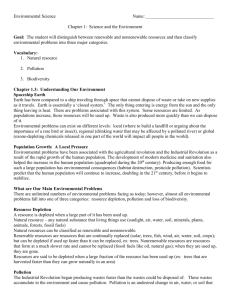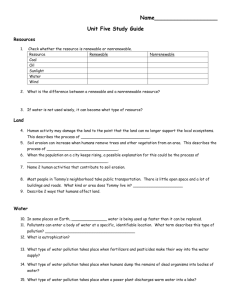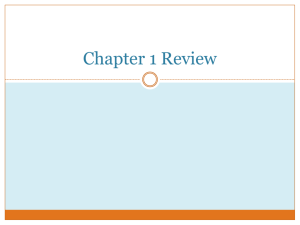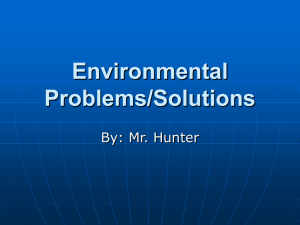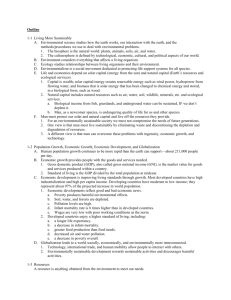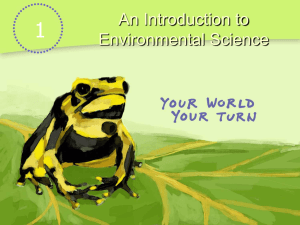Ecology Review
advertisement
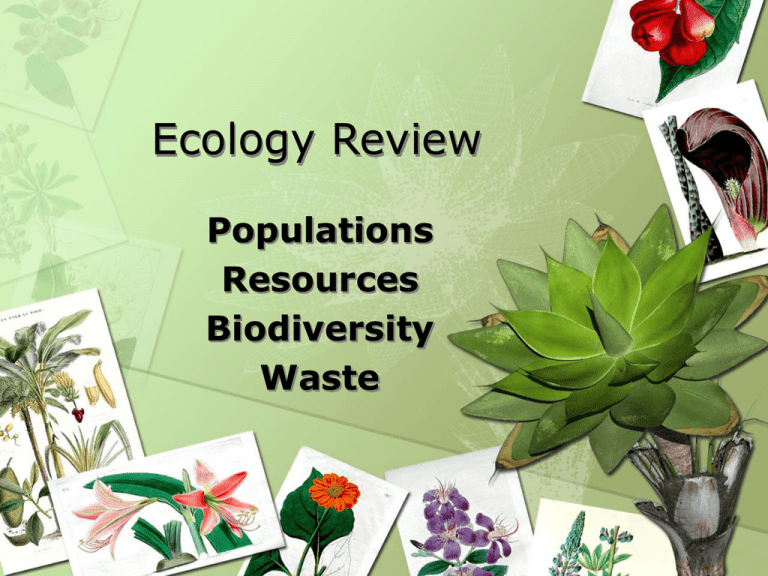
Ecology Review Populations Resources Biodiversity Waste 1. Exponential Growth • A. Remains constant • B. Starts out slowly and remains slow • C. Starts out slowly then becomes very rapid • D. Starts rapidly and remains rapid 2. Earth’s capital includes all of the following except: • A. Wildlife • B. Sunlight • C. Water • D. Soil 3. A sustainable society • A. lives off of income without depleting its earth capital • B. meets the needs of its people without jeopardizing the needs of future generations • C. Manages its economy and population size without exceeding the carrying capacity of the environment • D. all of these answers 4. Most of the environmental problems we face are • A. increasing linearly • B. decreasing linearly • C. increasing exponentially • D. decreasing exponentially 5. Approximately how long as the species Homo sapiens lived on Earth? • A. 4,000 • B. 12,000 • C. 60,000 • D. 100,000 6. Domestication of wild plants and animals occurred about ____ years ago. • A. 5,000 • B. 10,000 • C. 15,000 • D. 20,000 7. The industrial revolution began about ___ years ago. • 100 • 175 • 200 • 275 8. Which of the following characterize cultural revolutions? • A. Decreased food supplies • B. Increased resource consumption and pollution • C. Worsening living standards • D. Shorter life spans 9. Which of the following statements about developing countries is true? • A. They are highly industrialized. • B. They have high average GNPs per person • C. The US, Canada, Japan and western European countries are developing countries • D. They use about twelve percent 10. About ___% of the world’s human population lives in the developing countries. • A. 49 • B. 59 • C. 69 • D. 79 11. More than ___% of the projected increase in world population is expected to take place in developing countries. • A. 65 • B. 75 • C. 85 • D. 95 12. Since 1960, the gap between rich and poor, as measured by GNP per capita, has • A. decreased, then increased since 1980 • B. increased, then substantially decreased since 1980 • C. increased, then substantially increased since 1980 • D. decreased, then substantially decreased since 1980 13.For something to be classified as a resource, it must • A. satisfy a human need • B. Be steadily renewed or replenished • C. be a form of matter • D. exist in abundance 14. All of the following are potentially renewable resources except • A. groundwater • B. trees in a rainforest • C. fertile soil • D. oil 15. Use of a natural resource based on a sustainable yield applies to • A. renewable resources • B. nonrenewable resources • C. perpetual resources • D. amenity resources 16. Which of the following best describes the concept of environmental degradation? • A. using solar power at a rapid rate • B. using oil • C. cutting trees for wood products • D. letting agricultural runoff cause oxygen depletion and fish kills downstream 17. Resources that are called nonrenewable • A. are also called perpetual resources • B. are only resources that are alive • C. are capable of economic depletion • D. are derived from solar capital 18. All nonrenewable resources can be • A. converted to nonmetallic minerals • B. converted to renewable ones • C. exhausted or depleted • D. recycled or reused 19. Which of the following statements best illustrates the tragedy of the commons? • A. A factory pollutes a river as much as the law allows. • B. Some levels of pollution are life threatening. • C. Some activities harm the environment, but others do not • D. Irrigated cropland can be ruined 20. On the outskirts of a municipality lies a forest on public property. A person applying the precautionary approach • A. Clear-cutting the forest to provide taxes for the town • B. Converting the natural woods to tree farms • C. harvesting trees at their estimated sustainable yield • D. Harvesting trees below their estimated sustainable yield 21. New efforts to prevent the tragedy of the commons include • A. using common-property resources at or above their sustainable yields • B. converting land from private to more public ownership • C. moving from a taxpayers pay approach to a users pay approach • D. deregulation of industries that use common-property resources 22. Which of the following is an example of recycling? • A. Collecting and remelting beer cans • B. cleaning and refilling soft drink bottles • C. selling used clothing at a garage sale • D. saving leftovers in a peanut butter jar 23. We can extend use of nonrenewable resources by • A. reducing direct consumption of the resource • B. reusing the same form of a particular resource many times • C. recycling a resource into new products • D. all of these answers 24. When a resource is economically depleted, we can • A. Recycle or reuse existing supplies • B. waste less • C. develop substitutes • D. all of these answers 25. Pollution includes • A. dumping detergents into streams, causing fish kills • B. Spraying with DDT, lowering the eagle population • C. releasing gases from coal combustion, causing acid rain • D. all of these answers 26. Effects of pollution might include • A. being unable to see the top of skyscrapers because of smog • B. acid rain-induced destruction of a statue in your city park • C. spread of disease from an open dump • D. all of these answers 27. Point sources of pollution include all of the following except • A. an automobile tailpipe • B. a factory smokestack • C. a drainpipe from a power plant • D. runoff from cropland 28. Nonpoint sources of pollution include all of the following except • A. pesticides dispersed by airplane and wind onto a crop • B. runoff from a stockyard • C. a smokestack from a power plant • D. Fertilizer runoff from lawns. 29. Which of the following is not important in determining the damage caused by a pollutant? • A. concentration • B. persistence • C. origin • D. chemical nature 30. Persistent pollutants include • A. grass clippings • B. most plastics • C. paper cups • D. food waste 31. Nondegradable pollutants include • A. tin cans • B. human sewage • C. lead • D. detergent 33. You generally buy and eat microwave dinners. After dinner, cardboard tops and plastic trays remain. The least effective way to deal with this solid waste is to • A. store leftovers in the plastic trays • B. put all of the solid waste in household trash to be taken to the landfill • C. donate the plastic trays to the local nursery schools to use with preschoolers • D. recycle the components 34. Pollution cleanup approaches • A. may be overwhelmed by continuing population growth • B. often transfer pollutants between different parts of the ecosystem • C. May be very costly once pollutants are dispersed in the environment • D. all of these answers 35. Pollution prevention receives about ____% of the US environmental pollution budget • A. 1 • B. 10 • C. 20 • D. 30 36. Of the following major environmental problems, the one with the least effect on food supply is • A. groundwater depletion • B. overgrazing • C. outdoor air pollutants • D. soil erosion 37. Underlying root causes of unsustainable resource use include all of the following except • A. poverty • B. overpopulation • C. overreliance on renewable energy resources • D. prices that do not include environmental and social costs of products 39. Exponentially growing depletion and degradation of earth capital cause • A. soil erosion • B. loss of biodiversity • C. deforestation • D. all of these answers 39. A very simple model of environmental degradation and pollution would include all of the following except • A. number of people • B. the climate in which the people live • C. average number of units of resources each person uses • D. amount of environmental degradation and pollution generated 40. Of the following behaviors, the one that runs counter to the way the Earth works is • A. Recycling of materials • B. Controlling population growth • C. producing and consuming anything people are willing to buy • D. making sacrifices now for future generations 41. Of the following actions, the only one that does the least to sustain the Earth is • A. protecting Earth’s biodiversity • B. controlling human population growth • C. utilizing renewable resources whenever possible • D. increasing our dependence on nonrenewable resources

